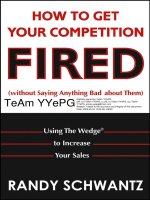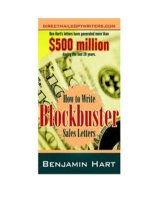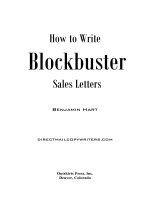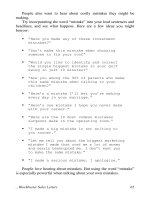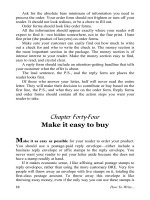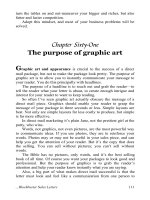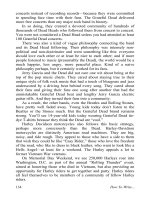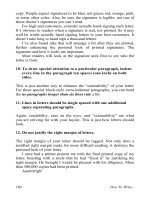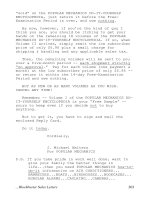how to get your competition fired (without saying anything bad about them) using the wedge to increase your sales
Bạn đang xem bản rút gọn của tài liệu. Xem và tải ngay bản đầy đủ của tài liệu tại đây (1.95 MB, 220 trang )
TeAm YYePG
Digitally signed by TeAm YYePG
DN: cn=TeAm YYePG, c=US, o=TeAm YYePG, ou=TeAm
YYePG, email=
Reason: I attest to the accuracy and integrity of this document
Date: 2005.03.16 13:04:26 +08'00'
How toGet
Your
Competition
Fired
(without Saying Anything
Bad about Them)
How toGet
Your
Competition
Fired
(without Saying Anything
Bad about Them)
Using The Wedge® to Increase Your Sales
Randy Schwantz
John Wiley & Sons, Inc.
Copyright © 2005 by Randy Schwantz. All rights reserved.
Published by John Wiley & Sons, Inc., Hoboken, New Jersey.
Published simultaneously in Canada.
The Wedge®, The Wedge® logo, and Selling Is a Contact Sport® are registered
trademarks of Schwantz and Associates, Inc.
No part of this publication may be reproduced, stored in a retrieval system, or
transmitted in any form or by any means, electronic, mechanical, photocopying,
recording, scanning, or otherwise, except as permitted under Section 107 or 108 of the
1976 United States Copyright Act, without either the prior written permission of the
Publisher, or authorization through payment of the appropriate per-copy fee to the
Copyright Clearance Center, Inc., 222 Rosewood Drive, Danvers, MA 01923,
(978) 750-8400, fax (978) 646-8600, or on the web at www.copyright.com. Requests
to the Publisher for permission should be addressed to the Permissions Department,
John Wiley & Sons, Inc., 111 River Street, Hoboken, NJ 07030, (201) 748-6011,
fax (201) 748-6008.
Limit of Liability/Disclaimer of Warranty: While the publisher and author have used
their best efforts in preparing this book, they make no representations or warranties
with respect to the accuracy or completeness of the contents of this book and
specifically disclaim any implied warranties of merchantability or fitness for a particular
purpose. No warranty may be created or extended by sales representatives or written
sales materials. The advice and strategies contained herein may not be suitable for your
situation. The publisher is not engaged in rendering professional services, and you
should consult with a professional where appropriate. Neither the publisher nor author
shall be liable for any loss of profit or other commercial damages, including but not
limited to special, incidental, consequential, or other damages.
For general information on our other products and services please contact our
Customer Care Department within the United States at (800) 762-2974, outside the
United States at (317) 572-3993 or fax (317) 572-4002.
Wiley also publishes its books in a variety of electronic formats. Some content that
appears in print may not be available in electronic books. For more information about
Wiley products, visit our web site at www.Wiley.com.
Library of Congress Cataloging-in-Publication Data:
Schwantz, Randy.
How to get your competition fired (without saying anything bad about them)
: using The Wedge to increase your sales / Randy Schwantz.
p. cm.
ISBN 0-471-70311-7 (cloth)
1. Selling. 2. Sales management. 3. Competition. I. Title.
HF5438.25.S3392 2005
658.85—dc22
2004017334
Printed in the United States of America.
10 9 8 7 6 5 4 3 2 1
To Lori, one of the world’s greatest jugglers,
a champion of kids, horses, and basketball, my pillar,
the apple of my eye, my one and only.
I also want to dedicate this book to you, the
salesperson. The work you do in keeping the
wheels of commerce turning is indispensable.
My fondest wish is that this book will help you
achieve your own goals sooner and provide
excellent, proactive service to more clients.
Contents
Preface
ix
Introduction
PART I
The #1 Obstacle to Most
New Business
The Strategy to Win
1
17
1 The Wedge
19
2 Finding Your Winning Difference
41
PART II
The Tactics That Work
65
3 The Wedge Sales Call
67
4 Discovering the Pain—The Problem Phase
79
5 Proposing a Remedy—The Solution Phase
107
6 Getting Your Competition Fired—
The Commitment Phase
121
PART III
Changing the Way Selling Is Done
133
7 Individual Success
135
8 The Wedge Sales Culture
147
vii
CONTENTS
9 For Buyers Only
183
10 For Current Providers Only
189
11 The Wedge Flight Plan: A Quick Review
193
References
201
Index
203
About the Author
209
viii
Preface
I
have more than 200 books on my bookshelf about selling.
They all say pretty much the same thing, that selling involves two people—the seller and the buyer. They say if
the seller can build a relationship with the buyer, find out
what the buyer needs, then bring in what the buyer needs,
the seller will be rewarded.
The reality is that there are three people in the selling
interview—the buyer, the seller, and the unseen current
provider. Not only do you have to be great at building relationships, you’d better be great at busting the incumbent
relationship.
The biggest challenge with traditional selling methods is that they don’t have a strategy for dealing with the
third party, the incumbent. Unless you have a strategy for
driving a wedge between the buyer and the current
provider in order to get your competition fired, the chance
is very good that the incumbent will leverage the existing
relationship with the client (your prospect) to get a “last
look” and match your proposal. You’ve just been rolled.
So the question is, how do you Get Your Competition
Fired without saying anything bad about them? Read on. . . .
ix
Introduction
The #1 Obstacle to
Most New Business
T
his book is the result of more than 10,000 hours I have
spent working with salespeople.
A lot of them, perhaps like you, were very motivated,
smart, hardworking, and yet frustrated. They were frustrated because they were not achieving the high goals they
had set for themselves. For them, hard work did not always
mean a higher income.
These were people who appeared to be doing everything right. They were excellent communicators and great
relationship builders. They listened to their prospects.
They were helpful and friendly. They brought back great
proposals at great prices. And on too many occasions, they
still did not get the business.
What I learned from my experience has helped many
of these people achieve their personal goals of doubling or
tripling their incomes, having more time for their families
and other personal relationships, and realizing the professional success that had escaped them for so long.
How did they do it? Did they work longer hours? Did
they call on more prospects? No. In fact, they quit playing
the numbers game. Instead, they focused their limited time
and energy on overcoming the number one obstacle to
selling most new business—their competition.
The Garden-Variety Sales Call
Many salespeople, when they target a prospect, are naturally eager to call on the prospect and start building a rela2
Introduction
tionship. After doing a limited amount of research, they
contact the prospect and schedule an initial appointment.
The typical sales call follows a predictable pattern, going
through three stages.
Stage 1
In the first stage, the salesperson has learned enough to ask
questions that make sense. He or she has done some research (not a lot yet), and is set on creating a friendly rapport to get things off to a good start. The conversation
goes something like this:
Seller: “Hello, Ray. I really appreciate your seeing me
today. How are things going?”
Prospect: “Pretty good, Bill. How about you?”
Seller: “Oh, fine. Thanks for asking. Tell me, how’s
business?”
Prospect: “Everything is going fine.”
Seller: “Well, as you know, I’m with Greater Smithville
Community Bank. We’ve been in business since
1953, and we’ve got 12 branches now in the
Smithville metropolitan area, not including our
other ATM locations. We’re proud to be the
banker for three other local firms in your industry. We sure would like to have a chance to handle your banking needs for you. Whom do you
bank with now?”
Prospect: “We’ve been with Giant National Bank for
six years, ever since they bought Smithville First,
our previous banker.”
3
INTRODUCTION
Seller: “How’s it going with Giant National?”
Prospect: “Fine.”
Seller: “Any problems with service?”
Prospect: “Not really anything to speak of.”
Seller: “What are your gross annual sales, Ray, more
or less?”
Prospect: “Well, last year they were $30 million, and
this year I think we’ll be at about $42 million.”
Seller: “I see. Any concerns with the rates Giant National gives you on loans, certificates of deposit,
other financial products?”
Prospect: “No. They’ve done a good job. Their rates
seem to be about normal.”
Seller: “What about your line of credit? Have they
treated you right on that?”
Prospect: “Well, it could always be a little more, I
suppose.”
Seller: “What about fees and other extra charges?”
Prospect: “Nothing special. They ding us on something
occasionally, but for the most part they’re pretty
normal.”
Seller: “Great. Ray, I’d like to put together a proposal
for you. I’d like to lay out what we can do for you
as your banker as you continue to grow. If we can
improve your line of credit and potentially save
you some money on other things, is there any
reason why we can’t do business?”
Prospect: “No, not at all. We’d be happy to entertain
what you’ve got.”
4
Introduction
Bill takes the information back to the main office, and
brings up the “Proposal” form on his computer screen. He
starts adapting it to fit the size of Ray’s company, and he
drops the name of Ray’s company into the boilerplate language. He consults the Giant National marketing materials
he has on file, looking up Giant National’s typical rates and
charges for small business customers like Ray. When his
vice president for business development, Ruth, asks him
how the new business appointment went, he tells her that
the prospect does not have any real problems to speak of,
but would be interested in an expanded line of credit,
which Greater Smithville Community Bank can do, and in
saving some on fees and other charges. They nod their
heads in agreement.
Stage 2
After Bill has completed his proposal, he puts it together in
a slick packaged presentation, and he calls Ray and sets up
an appointment.
Seller: “Thanks for having me back out, Ray. I think
you’ll like what I’m going to tell you.”
Prospect: “Sounds good. What have you got?”
Seller: “Well, basically we can expand your line of
credit by another $300,000, plus we can waive or
reduce a lot of the annoying charges you pay for
things like online bill payment, loan application
fees, and detailed summary statements. In fact,
we’ll even reimburse the ATM fees you pay when
you withdraw money from your business account
5
INTRODUCTION
while you’re traveling anywhere in the United
States. So what do you think?”
Prospect: “Well, Bill. It looks pretty good. I appreciate
what you came up with. We’ll definitely consider
your proposal. Let me look over what you put together, and we can talk next week.”
Seller: “Well, Ray, this is a pretty competitive proposal. Any reason we can’t get started now?”
Prospect: “Bill, I like what you’ve got here. I would just
like a few days to study it some. Please call me in
a few days.”
Seller: “That’s fine, Ray. I’ll check back with you in a
few days.”
Bill returns to his office and he runs into Ruth again.
When she asks him how it went, he tells her, “Terrific. I’d
say we’ve got an excellent chance. I’ve got a nice rapport
going with Ray. He likes what we brought to the table. I
expect we’ll hear something in the next few days.”
Stage 3
Meanwhile, Ray calls his banker at Giant National to talk
about the upcoming year. He asks what Giant National
might be able to offer based on his growth, and whether he
might be able to save any on his fees and charges. The
banker gets the feeling that something is going on, and he
asks Ray if he has some concerns. Ray tells him that, yes,
he is considering making a change, but he wanted to see
what Giant National could do before he did. At that point,
6
Introduction
Ray’s banker asks for a visit, and he gets in his car to go to
see Ray.
Current Banker: “Ray, I appreciate your call today. I
wanted to tell you how much your business
means to us. As you know, we’ve always been
willing to jump through hoops to meet your financial needs. I don’t know who you’re talking
to, or what they might be telling you, but I’m
sure we can expand your line of credit and be as
competitive on fees and charges as anyone. If we
can do that, do you see any reason why we can’t
continue our relationship? I know we can work
out whatever might be bothering you.”
Bill’s Prospect: “You’ve done a good job for us. If you
can help me out on the things I’ve mentioned,
we’ll stay with you.”
Current Banker: “I’m sure we can, Ray.”
A few days later, Bill calls Ray. He reaches Ray’s voice
mail, and leaves a message that he is checking in. The next
day, Ray finally returns his call.
Seller: “Hi, Ray. So how did we do?”
Prospect: “You were really thorough, and I want to
thank you for going through the trouble of getting us the proposal. I guess what it came down to
is that the line of credit issue and the fees and
charges weren’t something we couldn’t deal with
without changing horses right now.”
7
INTRODUCTION
Seller: “Okay, Ray. I hear you. Let me do this. I’ll keep
in touch, and maybe I can come back out there
later this year and see where you are then.”
Bill makes a note to call on Ray again in six months.
When Ruth sticks her head in the door to see how it went,
Bill explains, “Maybe we couldn’t improve Ray’s situation
enough compared with what Giant National is doing for
him. But, anyway, he seems too satisfied right now to
switch banks. I’ll keep after it, though.”
Bill just got “rolled.” It happens to many salespeople who
go in slinging their sales pitch and often are too ready to
offer a quote to try to save the prospect money. The real
problem is that Bill had a weak sales strategy. Although he
made an effort to find out about any problems or frustrations that his prospect might be having with Giant National Bank, his process did not find any that made a big
enough difference. Nor did he take into account that Giant
National already had the relationship, and probably would
get—and did get—a chance to explain its own advantages,
improve Ray’s line of credit, and lower or waive a fee here
and there when he called to compare. Bill also failed to differentiate Greater Smithville Community Bank from Giant National. He merely talked about the fact that his bank
had a local presence, its years in business, its locations, its
customers—the things that make most banks the same.
In short, Bill made no effort to identify any truly
meaningful differences between his own bank and his competition, Giant National. He identified nothing that would
strongly motivate Ray to consider switching. As a result, he
8
Introduction
never really had anything to sell other than a price difference and the same willingness to expand his prospect’s line
of credit that other banks have. Like many salespeople who
rely on traditional selling methods, he got rolled.
Tactics You Can Use Right Away
In this book I show how to overcome the natural advantage
of the current provider, and how to gain an edge over any
competitor. I give you proven tactics that you can use to
get your competition fired from an account, or from being
considered for an open account that you want, without
your having to say anything bad about your rivals. Together, these tactics and the strategy on which they are
based are known as The Wedge.
If you are like me, you have sat through many sales
courses and read the standard books. I remember walking
into many of these classes saying to myself, “If I can get
just one good idea, this is probably worthwhile.” Many of
the good ideas that I got, though, were so conceptual that
it took a lot of time to convert them into day-to-day,
practical methods that would help me sell more now and
make more money. It was like going to a supermarket for
dinner rather than going to a restaurant. At a supermarket, you have to buy all the ingredients, take them home,
and prepare your meal yourself rather than walking in,
ordering something off the menu, and leaving 30 minutes
later satisfied.
Unlike traditional selling, The Wedge is a ready-toeat meal. This book gives you simple, practical techniques
9
INTRODUCTION
that have worked for others. I am not talking about ideas,
concepts, and theories that leave it up to you to figure out
how to apply them. I am talking about no-nonsense, easyto-grasp tactics that you can start using tomorrow morning
to get results.
The Wedge is not an alternative to Selling 101. As
we discuss The Wedge, I assume that you know many of
the basics of selling—how to create rapport, effective
communications skills, and so on. Unavoidably, some of
the ground we cover may sound familiar to you. However, you will notice an important difference. The
Wedge, with its focus on the relationship between your
prospect and your competitor, takes the selling process
to a higher level. It is more like Sales 401, building on
what you already know.
The Wedge is based on a practical reality that traditional selling largely ignores. Conventional wisdom says a
selling situation involves two parties—a seller and a buyer.
Conventional wisdom is wrong. Most major selling opportunities involve three parties—you, the prospect, and your
competition. Until you have a strategy for dealing with
your opponents, you do not have a sure prospect.
The salesperson who currently has an account is particularly in the driver’s seat. He or she already has the relationship with the prospect, and is going to do everything
possible to keep the business. Therefore, to create an opportunity to win the account, you must first drive a wedge
between your prospect and the provider. Of course, here is
the problem. You cannot walk into prospects’ offices and
start bad-mouthing the companies whose services they
made the decision to employ. Do that, and you might as
10
Introduction
well say, “Let me get this straight, Joe. Were you the person who actually hired these people?”
Your challenge is—without criticizing your competition—to help your prospects see that they are being underserved by your rivals leading them to decide on their own
that they would be better off if they switched or gave their
business to you. Learn how to do that, and you can start
winning larger, more profitable accounts faster than you
ever have.
Facing a Fundamental Truth
I also wrote this book because other sales books (and I have
read most of them) do not address a fundamental truth
about selling. Most of the time, someone must lose for you
to win. That is the truth.
Yet, calculating how to get people fired is often considered harsh at best and unethical at worst. Civilized
people do not set out to take bread off the tables of their
competitors. So we fancy selling as a solo sport, like figure skating. You skate out onto the ice. You smile and do
your routine, hoping that your artistry and technical skills
will impress the judges enough for you to win the gold.
You nail your triple axels, and become one with the music. When you have finished your presentation, you take a
bow and wait for the judges to hold up their cards. You
wait confidently, thinking to yourself, “I know I’m going
to get a 10.” Blissful and expectant, you look at the crowd
on the edge of its seats, sharing this moment with you,
and then . . .
11
INTRODUCTION
Wham!
Just like in hockey, someone comes skating out of
nowhere, knocks you off your imagined pedestal, and
skates away with your medal. Welcome to the real world,
where selling is a contact sport, where often the prospect
and a person who already has the business are the home
team, and where you are the visiting underdog.
The Golden Rule
Even when they realize that selling is a contact sport, some
salespeople feel squeamish about waking up each day and
figuring out whose accounts they can take away. Somehow,
we have gotten the idea that getting people fired replaces
the Golden Rule with the cynical notion that gold rules,
and decency be damned. “Hi, honey. I’m home. Guess
what? I got three people axed today. Pretty cool, huh?”
This notion is 180 degrees wrong. If you are not successful at getting buyers out of inferior relationships and
into better ones, you are leaving those buyers stuck with
mediocre service for weeks, months, or years. If you do not
help them see the difference and gain the courage to fire—
or not to hire—your competition, then you are letting
them down. You are doing unto them what you would not
want them to do unto you. This is especially important today, when every company must measure up to a general
standard in order to stay in business and do well.
If your company cannot do a better job than your rival, then yes, it would be wrong for you to bust the relationship only to then give your new client inferior service;
12
Introduction
but if you are truly better, then you owe it to yourself and
your prospect to do all you can to get your competition
fired so that you can take over the account.
The Virtue of Being Fired
For the intelligent salesperson, getting fired for the right
reason is a blessing in disguise. For average salespeople, it
is just something bad that happened to them. Smart salespeople, however, use the experience to focus on what they
were doing wrong, and how they can become better. To the
degree that the threat of losing an account makes them
work harder to win and keep their customers, that is a good
outcome, too. In either case, seeking to have them fired
sorts the deck of business relationships into pairs that are
healthier and more productive all the way around.
Getting unworthy service providers fired is also good
for the economy. When you lose a sale because you did not
have a strategy for taking out your competitor, it is not just
a setback for you. Everybody loses. You lose time. Your
company loses money. Your prospect loses the benefit of
what you failed to sell. And all of us pay higher prices for
the goods and services we buy as your company passes
along its higher-than-necessary “sales acquisition costs.”
Why The Wedge Works
If you are like me, you are skeptical about theories and abstract models when it comes to selling. You know how
13
INTRODUCTION
things work in the real world. No course or textbook can
fully capture what a salesperson goes through. The Wedge
is not merely a model. It is a complete selling system with a
proven set of tactics wrought from actual sales experience.
It is a step-by-step process; you and your company can use
it to drill down and find your true competitive advantage,
break it down into simple chunks, and put these chunks
into questions to ask your prospects. These questions will
get them to see that they are being underserved and that
they would be better off with you—without your having
said saying anything bad about your competition or telling
your prospects how great you are.
Your Real Competitive Advantage
The Wedge works also because it is based on finding and
using your real competitive advantage. What do I mean by
real competitive advantage?
Your company and others basically compete on three
things: price, product, and service. When it comes to price,
your competitors in most cases can beat your price if they
choose to. How great a salesperson does it take to sell on
price? Moreover, price differences among comparable services and products are usually too marginal to be decisive.
There is no sustainable competitive advantage in price.
As far as most products are concerned, there is not a
lot of real differentiation among them within the same
category. If you do offer a product with a truly meaningful
difference, then you can leverage that. More often than
not, however, product differences are not major enough to
14

